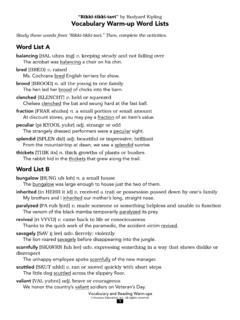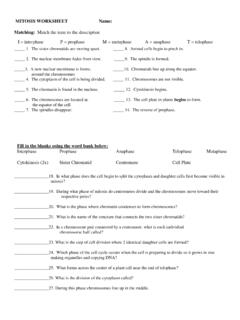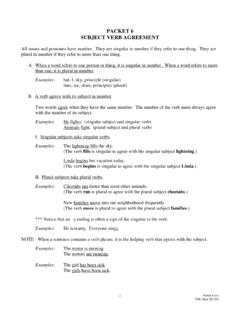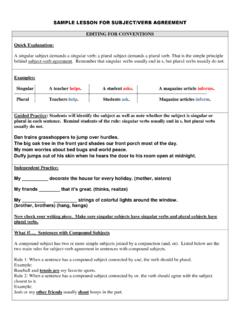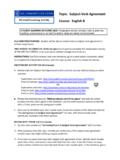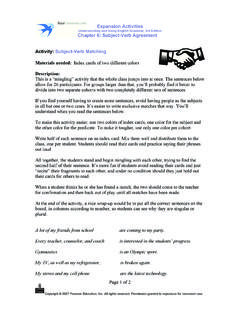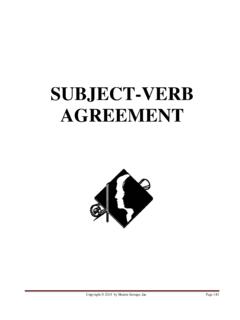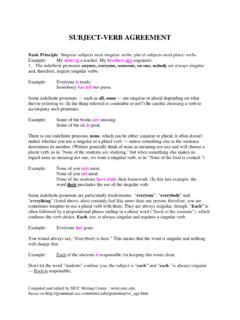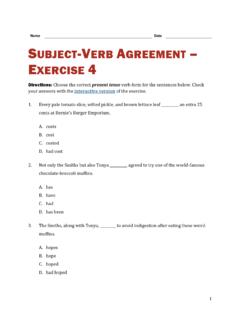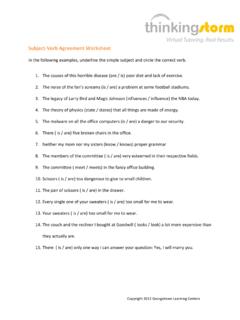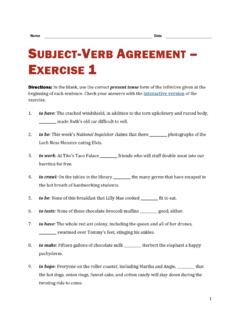Transcription of Grammar Notes: Subject / Verb Agreement
1 Grammar notes : Subject / verb Agreement Subjects and verbs must agree with one another in number. In the present tense, a singular Subject takes a singular verb , and a plural Subject takes a plural verb . Below is a list of common Subject - verb Agreement rules. Singular verbs end in s or es. Unlike nouns, the plural form of a verb is not made by adding an s or es to the ending. It's actually the opposite. For present-tense verbs, adding the s to the end makes it singular. If the verb is plural, there is no s ending used. Singular Verbs Plural Verbs The puppy sleeps soundly. The blanket needs washing.
2 The puppies sleep soundly. The blankets need washing. Compound subjects joined by "and" take a plural verb . A Subject that is made up of two or more nouns is a compound Subject . When the parts are connected by and, the Subject is plural, so it takes a plural verb . The goose and the duck waddle by the pond. Jack, Kara, and Sandy play leapfrog together. Subjects with singular nouns joined by or or nor take a singular verb . Either you or your sister waters the plants. Neither the treats nor the catnip calms the cat. Subjects with a singular noun and a plural noun joined by or or nor take the verb that agrees with the closer noun.
3 Syrup or raisins taste good with oatmeal. Neither the students nor their teacher comes to school during a snowstorm. Subjects are not in modifying phrases. When the Subject and the verb are separated by other words or phrases, make sure the verb agrees with the Subject , not with a noun within the phrase. One of your buttons is missing. Our neighbor who grows tomatoes shares his harvest with us every year. The citizens of Murphy, Texas, vote today. Don't let those phrases fool you. Phrases using with, together with, including, accompanied by, in addition to, or as well do not change whether a Subject is singular or plural.
4 If the Subject is singular, the verb should be as well. The outfit, including the socks, costs $45. The twins, as well as their baby brother, ride in the shopping cart. Nouns with a plural form but with a singular meaning take singular verbs. Nouns such as United States, civics, mathematics, measles, and news take singular verbs. Alvin and the Chipmunks is a cute movie. Fifteen dollars is too much for a movie ticket. Nouns such as scissors, tweezers, trousers, jeans, and shears take plural verbs. These nouns may appear to have a singular meaning, but each of these things is made up of two parts.
5 Tori's shorts look comfortable. Tim's glasses make him look smarter. Collective nouns usually take singular verbs. A collective noun has a singular form even though it refers to a group of individuals or things. Examples include army, audience, crowd, group, team, committee, class, and family. These nouns take a singular verb when the group acts as one unit. The flock follows the shepherd. The band plays jazz music. The team wins every game. However, a plural verb is used when people or things within a group act separately. The team disagree about where to celebrate after the game.
6 If the Subject follows the verb , the Subject and verb should still agree. When the normal Subject - verb order is inverted in a sentence, the verb still agrees with the Subject . For example, in sentences beginning with there or here, the Subject follows the verb . Since neither there nor here is ever the Subject of a sentence, the verb agrees with the noun that follows the verb . There is a bird on the fence. Here are your clean clothes. With words that indicate portions, look to the object of the preposition. With words that indicate portions percent, fraction, part, majority, some, all, none, remainder, and so forth look at the object of the preposition (the noun following the of phrase) to determine whether to use a singular or plural verb .
7 If the object of the preposition is singular, use a singular verb . If the object of the preposition is plural, use a plural verb . Two-thirds of the candy bars were chocolate. Twenty percent of the students are fourth graders. Be careful with indefinite pronouns. Indefinite pronouns do not replace a specific noun. The words each, each one, either, neither, everyone, everybody, anybody, anyone, nobody, somebody, someone, and no one are singular and require singular verbs. The words both, few, many, others, and several are plural and require plural verbs. The words all, any, more, most, none, and some may be either singular or plural depending on what the indefinite pronoun refers to.
8 Someone in the back of the bus likes paper airplanes. Both of the boys have have funny haircuts.

